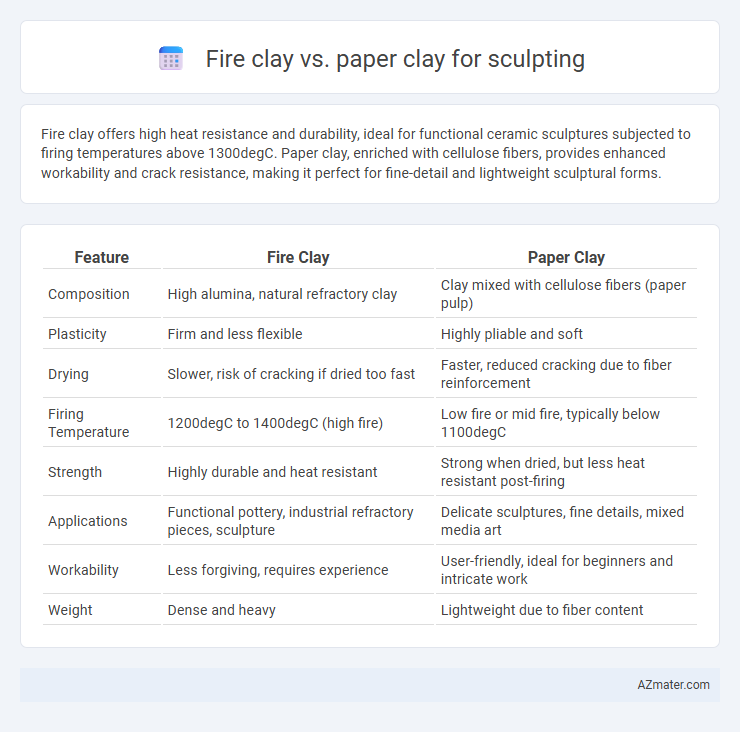Fire clay offers high heat resistance and durability, ideal for functional ceramic sculptures subjected to firing temperatures above 1300degC. Paper clay, enriched with cellulose fibers, provides enhanced workability and crack resistance, making it perfect for fine-detail and lightweight sculptural forms.
Table of Comparison
| Feature | Fire Clay | Paper Clay |
|---|---|---|
| Composition | High alumina, natural refractory clay | Clay mixed with cellulose fibers (paper pulp) |
| Plasticity | Firm and less flexible | Highly pliable and soft |
| Drying | Slower, risk of cracking if dried too fast | Faster, reduced cracking due to fiber reinforcement |
| Firing Temperature | 1200degC to 1400degC (high fire) | Low fire or mid fire, typically below 1100degC |
| Strength | Highly durable and heat resistant | Strong when dried, but less heat resistant post-firing |
| Applications | Functional pottery, industrial refractory pieces, sculpture | Delicate sculptures, fine details, mixed media art |
| Workability | Less forgiving, requires experience | User-friendly, ideal for beginners and intricate work |
| Weight | Dense and heavy | Lightweight due to fiber content |
Introduction to Fire Clay and Paper Clay
Fire clay, a high-temperature refractory material, boasts excellent heat resistance and durability, making it ideal for sculpting ceramics or pottery that require firing. Paper clay, composed of traditional clay blended with cellulose fiber, enhances workability and reduces cracking by adding lightweight, flexible strength during drying and firing. Both materials cater to distinct sculpting needs, with fire clay favored for structural integrity under heat and paper clay preferred for intricate, delicate details and ease of manipulation.
Composition and Material Differences
Fire clay primarily consists of refractory aluminosilicate minerals that withstand high temperatures, making it ideal for ceramics subjected to extreme heat. Paper clay incorporates cellulose fibers mixed with traditional clay, enhancing its tensile strength, flexibility, and drying properties, which benefits sculptors during construction and assembly. The main material difference lies in fire clay's high-temperature resistance versus paper clay's fiber-reinforced structure that supports lightweight and intricate forms.
Workability and Sculpting Techniques
Fire clay offers high plasticity and durability, allowing sculptors to create detailed, intricate forms that can withstand high firing temperatures without cracking. Paper clay, infused with cellulose fibers, enhances workability by improving flexibility and reducing drying time, which benefits wet sculpting, joining, and fine detail adjustments. Techniques like pinching, coiling, and slab building are easier with paper clay due to its lightweight and adhesive qualities, while fire clay excels in hand-building and wheel throwing for strong structural pieces.
Strength and Durability of Finished Pieces
Fire clay offers exceptional strength and durability in sculpting due to its high refractory properties and resistance to cracking during firing, making it ideal for functional pottery and robust art pieces. Paper clay incorporates cellulose fibers that improve workability and reduce drying cracks, but the finished pieces generally exhibit lower mechanical strength compared to fire clay after firing. For long-lasting sculptures requiring high structural integrity, fire clay is the preferred material over paper clay.
Drying and Shrinkage Factors
Fire clay exhibits lower drying shrinkage compared to paper clay due to its dense particle composition, making it more stable for intricate sculpting with minimal risk of cracking. Paper clay contains added organic fibers that improve workability and reduce drying stress, allowing for faster drying times but with slightly higher shrinkage potential. Both clays require controlled drying environments, yet paper clay's flexibility during drying makes it preferable for complex sculptures prone to warp or crack.
Firing Requirements and Temperature Ranges
Fire clay requires high firing temperatures typically between 1200degC to 1400degC to achieve durability and strength, making it ideal for functional pottery and sculptures exposed to heat. Paper clay contains fibrous paper pulp, allowing for lower firing temperatures around 900degC to 1100degC, which helps retain detail and reduce shrinkage during firing. Understanding the distinct temperature ranges and firing requirements of fire clay and paper clay ensures optimal results based on the intended sculpting project.
Surface Texture and Detailing
Fire clay offers a dense, coarse surface texture ideal for robust, earthy sculptures, enhancing naturalistic details with its firm consistency. Paper clay, infused with fibers, provides a smoother, more pliable texture allowing for refined detailing and delicate surface work, making it excellent for intricate sculptural elements. Artists choose fire clay for its durability and textural depth, while paper clay excels in achieving fine, precise finishes with ease of manipulation.
Weight and Handling Considerations
Fire clay is denser and heavier, providing substantial weight that contributes to strength and durability in sculptures, making it ideal for large or structural pieces. Paper clay incorporates paper fibers, resulting in a lighter, more porous material that is easier to manipulate and handle during sculpting, especially for fine details and delicate forms. The reduced weight of paper clay also allows for more efficient drying and less risk of cracking, enhancing overall handling comfort.
Suitability for Beginners vs. Professionals
Fire clay offers durability and high firing temperature resistance, making it ideal for professional sculptors seeking long-lasting, detailed works that can withstand intense kiln conditions. Paper clay, mixed with cellulose fibers, provides lightweight, flexible, and easy-to-sculpt properties which are especially suitable for beginners learning hand-building techniques and experimenting with delicate forms. Professionals may also use paper clay for complex armatures or mixed-media pieces, leveraging its crack resistance during drying and ease of repair compared to traditional fire clay.
Cost and Availability Comparison
Fire clay is generally more affordable and widely available in hardware stores and ceramic supply shops, making it a cost-effective choice for sculptors. Paper clay, while sometimes pricier due to its specialized additives and limited retail presence, offers enhanced workability and strength when dry. Both materials vary in price depending on brand and quantity, but fire clay typically provides easier access for large-volume projects.

Infographic: Fire clay vs Paper clay for Sculpting
 azmater.com
azmater.com